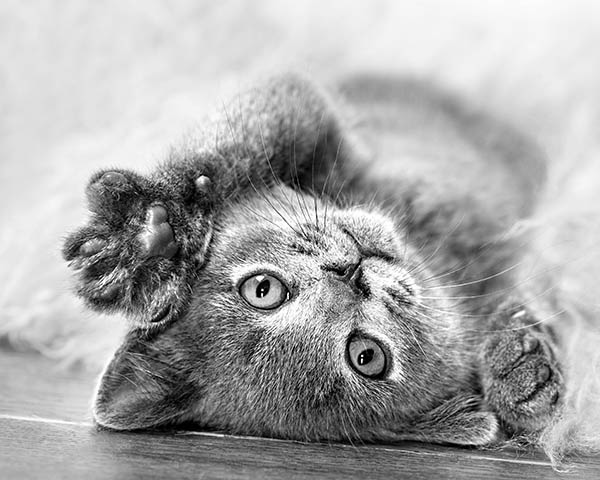How can I get my kitten to use the litter tray?
Litter training a cat can result in poopy paws and wet floors. Some days, potty training might get messy, and all your efforts go down the toilet (if you’re lucky). Don’t worry, your not-so-feral feline can learn to use the litter tray and become an upstanding member of the household.
Learn everything you need to know about litter training your cat with these tips.
Keep it clean
It’s important to keep your cat’s litter tray clean, or they may find somewhere else to go to the toilet. Early on, try to give your cat’s litter box a scoop and add some clean litter after each time they use it. Your furry feline will need about 2-to-3 inches to dig. In time your cat will learn where to go, and you’ll be able to clear the mess daily once your cat is consistently using their litter box.
Try to give your cat’s litter tray a thorough clean now and then too. This will keep smells to a minimum and help keep your home hygienic.
Put it in a safe place
If your cat isn’t happy with the location of their litter box, they’re more likely to do their business around the house. Cats prefer somewhere safe and quiet to go to the bathroom. Keep your corners and crevices clean, by finding a safe place for your cat to be private.
Place their litterbox in a quiet part of the house, where they won’t be disturbed. During this time, cats are vulnerable so they may prefer a sheltered litter box tucked into a quiet corner. Try to avoid placing the litter tray next to large windows, cat flaps, hallways, or near their food or sleeping areas . If your cat hasn’t been going where you want them to, try moving it to a more secluded spot.
If you’re litter training your kittens, they may need simply pointing in the right direction. If your kitty looks ready to visit the litter box, just place them near their tray to encourage them. It may take a few misfires, but they should get the gist.
Reward success
If you’re litter training your kitten, reward them for a job well done with treats and praise. Soon, they’ll associate going to the toilet correctly with rewards. In time, you won’t even need to bribe your cat to go to the litter box. They’ll be slinking off and taking care of business without the fanfare.
Find out what they like
Got a fussy feline? Cats have personalities and preferences. You can try out different litter trays, litter materials, and sizes to encourage them to go in the right place. You’ll also need to size up your litter tray as your kitten gets bigger – you wouldn’t want to use a potty, after all.
Some cats may prefer a litter tray with walls, others a covering, and some are okay with the standard open tray. Try to choose a tray they enjoy, and always have one more tray in the house than the total number of cats you have, so they have options.
Look out for your cat
Remember, all the litter training in the world won’t matter if your kitten is feeling sick, stressed or anxious. Cats who aren’t well are more likely to have accidents, and that may be on you or your rug. If their poo looks different from normal , this could be a sign something is wrong. So, do your best to pay attention to your cat and meet their needs .
If your cat is struggling to wee, they could have a urinary tract infection (UTI). Try to look for the signs, such as straining, yowling, strong odour or blood in the urine . If your cat has a UTI, you’ll need to visit a vet.
Cat insurance can help cover the cost of vet visits, treatments and medications if your cat does fall ill. Learn more about Sainsbury’s Bank Pet Insurance for Cats, and get access to vet assistance day and night.
Top tips for litter training a kitten
Litter training a cat or kitten might sound like a daunting, and even messy, task. these top tips for litter training your kittens and cats without a fuss:
• Always keep the litter tray clean, as cats and kittens dislike a dirty bathroom.
• Try to keep your cat calm and stress free, so there’s no accidents around the house.
• Clean up any accidents right away and spray with odour neutraliser to prevent them going there again.
• Careful with cleaning products as some may be harmful to cats or give off a strong scent.
• Experiment with different types of trays, tray placement and litter.
• Don’t punish your cat – instead, reward good behaviour. You want them to see the tray as a positive.
• Start litter training your kitten as early as possible.
• Don’t rush – litter training your kitten can take time, so be patient.
Why your kitten won’t use the litter tray
You can do everything right, but sometimes your kitten just won’t use their litter tray – even if they’ve used it before. It’s not always obvious why this might be, but there are some common reasons why your kitten or cat won’t use the litter tray, including:
- Stress. If your furry friend is down in the dumps, they’re more inclined to have accidents. Stress can come in many forms, including environmental changes both inside and outside the home.
- Medical conditions. If your cat is suffering from a health condition, they may struggle to control their bladder, or it could be causing them stress.
- Dislikes the litter. Cats can be picky, and they may not like the litter (or it may not be deep enough for them to dig.) Experiment with different volumes and types of litter to find out what they prefer.
- Declawing. If your cat has been declawed, they may not want to enter the litter box as their paws are sensitive and sore from surgery. You could try a softer type of litter, like pinewood shavings for a while.
- Cleanliness. This isn’t a preference – your kitten or cat will actively avoid the litter box if it’s messy. Try to clean after each elimination, or at the very least daily for older cats.
- Territory issues. If your cat doesn’t feel like they can claim the territory the litter box is in, they may be averse to using it. Try not to put the litter box next to large windows, where your cat might spot others spying on them – this can cause them stress.
- Environmental issues. Introducing a new pet to the household, or changing your cat’s routine, can cause stress. Depending on how your cat reacts, this could lead to litter box avoidance. Try to introduce changes slowly, so that your cat can become accustomed to them.
- Bad associations. One of the reasons you should focus on praise and not punishment is so your kitten doesn’t draw negative associations to the litter box.
- Too much space. If you’re litter training your kitten, start off in a small and cozy room – but ensure the litter box is separate from food or play zones. Teaching them to use the litter tray in this setting is easier than opening up the entire house, which could lead to accidents.
Frequently asked questions
How long does it take to toilet train a kitten?
On average, toilet training your kitten can take about four to six weeks. With a bit of patience and a heap of positivity, your kitten can go from hallway puddles to litterbox royalty in no time. Remember, it’s best to start small and train in a single room, slowly introducing more of the home.
What age should kittens be potty trained?
Kittens can start litter box training early, after only three to four weeks, once they start weaning from the mother and eating solid foods. At eight to 12 weeks old, they should be capable of using the litter box.
How do I get my kitten to go to the toilet?
There are a lot of ways to get a kitten to go to the toilet, but you should start by litter box training them in a small room. Try to keep their tray clean, then start reinforcing good behaviours when they do use it with lots of praise. If you can, try to use the same shape and size litterbox that the breeder or shelter used initially.

Browse our cat guides
Choose from our list of helpful guides and information

Cat breed guides
How to care for your cat, common health problems and more

Explore dog breeds
Find out how to keep your dog healthy and happy
Terms and conditions
Important information
* The discount is based on information related to you and the Sainsbury’s and Sainsbury’s Bank transactions linked to your Nectar account. For more information on how we use your data, go to sainsburysbank.co.uk/privacy
Sainsbury's Bank plc, Registered Office, 33 Holborn, London EC1N 2HT (registered in England and Wales, no. 3279730) is authorised by the Prudential Regulation Authority and regulated by the Financial Conduct Authority and the Prudential Regulation Authority (register no. 184514). Sainsbury's Supermarkets Ltd is an appointed representative of Sainsbury's Bank plc.
Sainsbury's Bank plc acts as an introducer to Pinnacle Insurance plc who is authorised by the Prudential Regulation Authority and regulated by the Financial Conduct Authority and the Prudential Regulation Authority (register number 110866). Registered Office: Pinnacle House, A1 Barnet Way, Borehamwood, Hertfordshire, WD6 2XX. Sainsbury’s Bank plc and Pinnacle Insurance plc are not part of the same corporate group.
